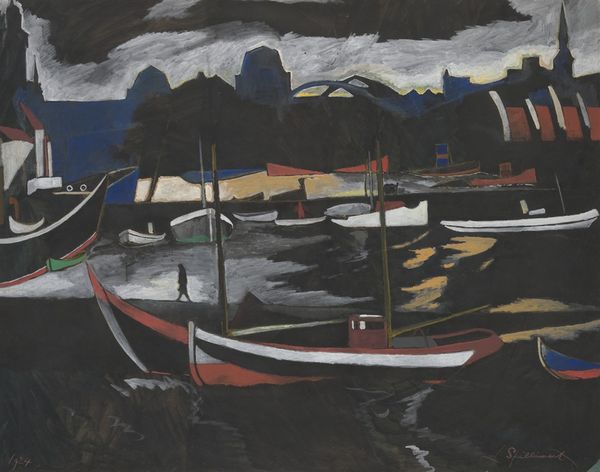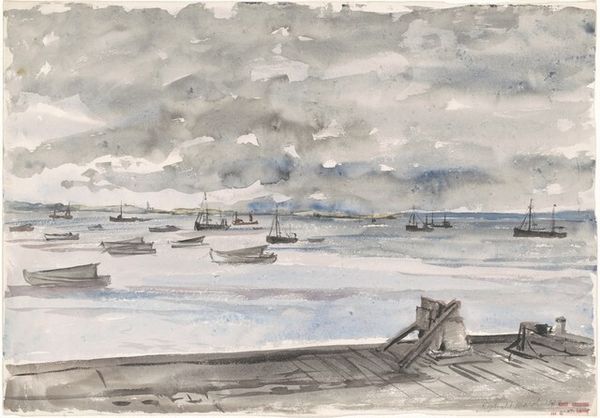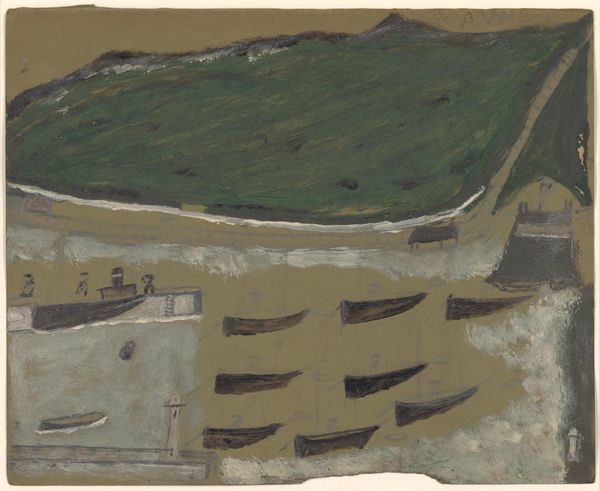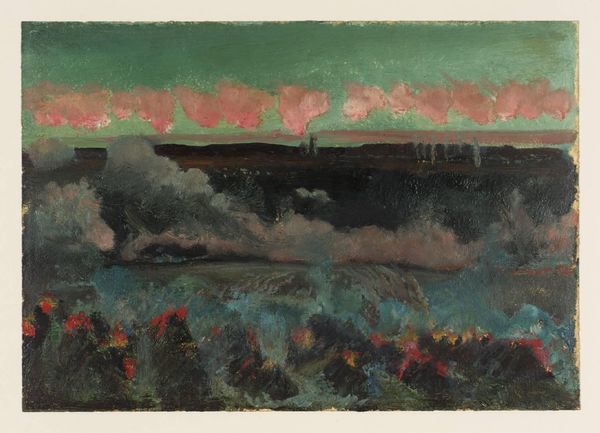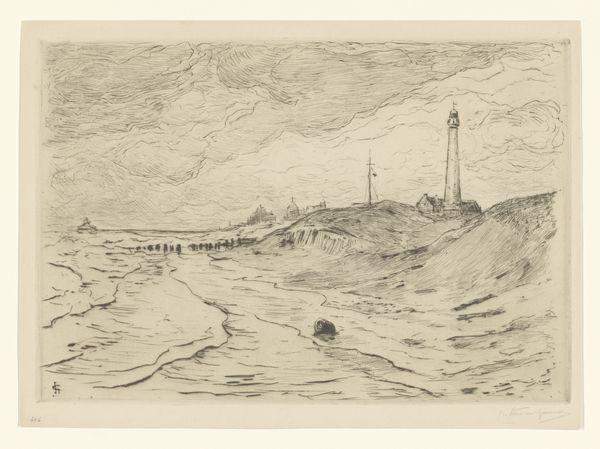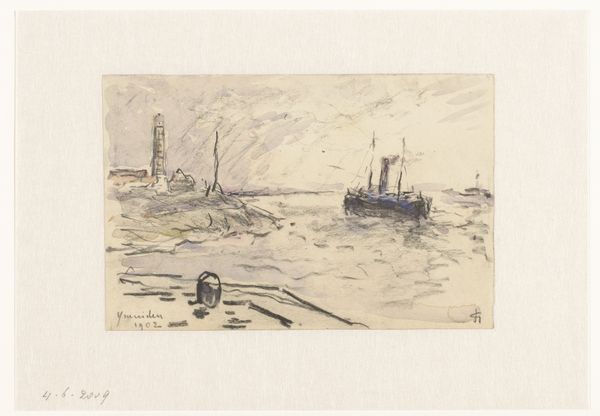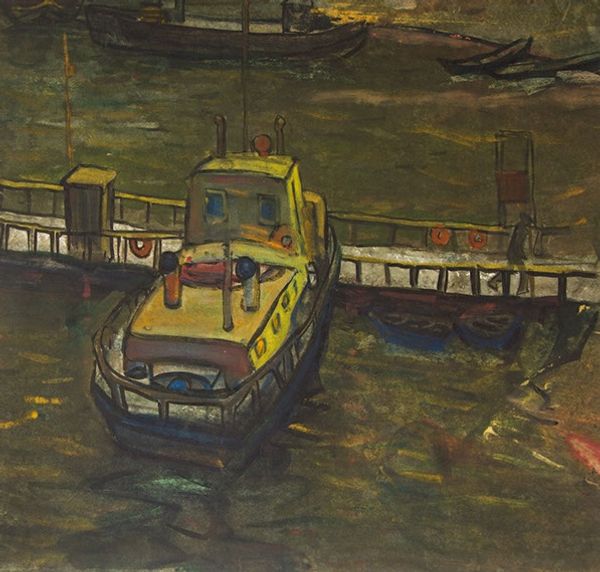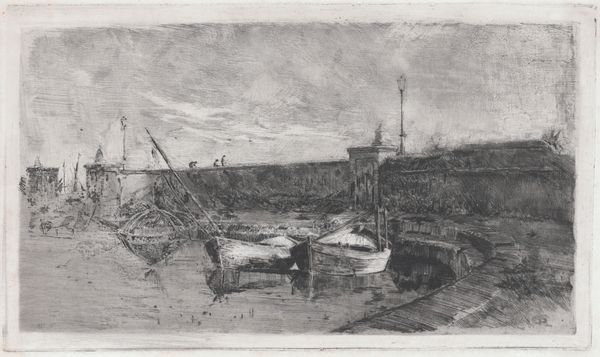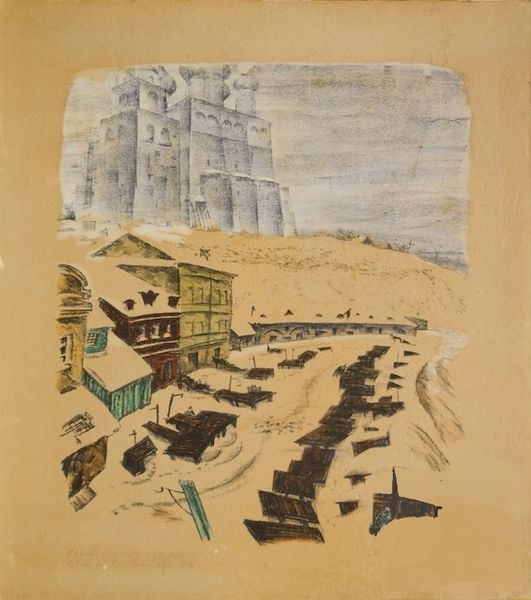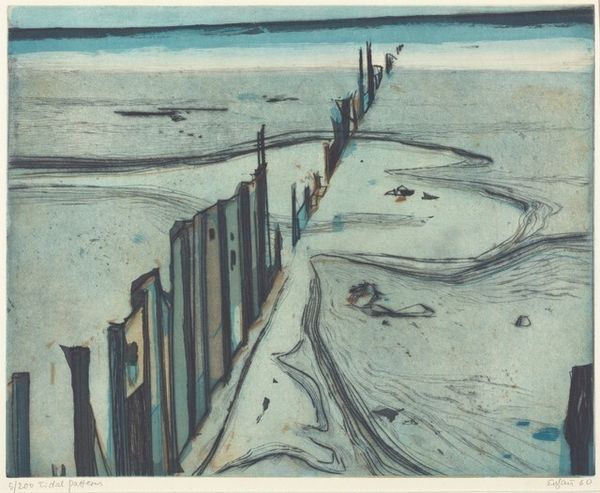
Dimensions: support: 377 x 683 mm frame: 576 x 882 x 52 mm
Copyright: CC-BY-NC-ND 4.0 DEED, Photo: Tate
Editor: Here we have Alfred Wallis's "Wreck of the Alba," painted sometime in the early 20th century. It's oil on cardboard, and I’m immediately drawn to its flattened perspective and the almost naive depiction of the ships. What do you see in this piece? Curator: Wallis, a self-taught fisherman-turned-painter, offers us a direct view into his lived experience. The tilted perspective, the crude representation of the boats--it’s not about accurate representation, but about capturing the essence of his maritime world. How do you think the context of Wallis's life as a working man informed his artistic choices? Editor: I guess it makes sense that he's not trying to be academic or traditionally beautiful, he's just documenting what he knows. That rawness is compelling in its own way. Curator: Exactly! And it challenges the traditional art world's focus on idealized depictions, giving voice to a different narrative. It makes you consider whose stories are deemed worthy of representation, doesn't it? Editor: Definitely. It gives me a lot to think about regarding art's purpose and who gets to define it.
Comments
tate 6 months ago
⋮
http://www.tate.org.uk/art/artworks/wallis-wreck-of-the-alba-t06871
Join the conversation
Join millions of artists and users on Artera today and experience the ultimate creative platform.
tate 6 months ago
⋮
In this highly dramatic painting Alfred Wallis depicted a ship floundering in turbulent seas at Porthmeor Beach, St Ives. Whereas his paintings of ships, houses and seascapes usually told of 'what use to Bee' (quoted in Jones, p.11), Wreck of the Alba confronted a contemporary disaster which Wallis almost certainly witnessed himself. On 31 January 1938 the 3,700-ton Panamanian steamer Alba, loaded with a cargo of coal, ran aground in stormy weather en route from Barry in South Wales to Civitavecchia in Italy. In a gripping sequence of events the St Ives lifeboat was launched and the Alba's Hungarian crew of twenty-three was safely evacuated. Yet as the lifeboat came round the bow of the wreck a huge wave crashed into the craft, capsizing it and tossing it onto the Island, a stretch of land jutting into the sea. It was only thanks to the effort of 'hundreds of St Ives people [who] scrambled over dangerous rocks to help the men' (Western Morning News, 3 February 1928) that the lifeboat crew and all but five men from the Alba were saved. The shipwreck immediately captivated Wallis, who had lived close to Porthmeor Beach in a small cottage at 3 Back Road West since 1912. As a fisherman in the 1870s and 1880s, sailing in schooners and windjammers off the Cornish coast and even crossing the Atlantic to Newfoundland, he had experienced at first-hand the perils of life at sea. Later, as a 'Dealer in Marine Stores' in St Ives from 1890 until the early 1910s, he made his living dealing in scrap from shipwrecks and deserted vessels. When he began regularly painting in the mid-1920s after the death of his wife Susan Ward, Wallis continued to use the recycled materials of the rag-and-bone trade. He painted on a variety of surfaces, from scraps of cardboard provided by the local grocer Mr Baughan to tea boxes, old calendars, jars, mugs and even a pair of bellows. For Wreck of the Alba he chose a long rectangular plywood panel probably originating from the lid of a box or shipping container. Choosing not to modify the board he incorporated its original format into the painting, even leaving nails and holes intact. Working at his cottage with the panel propped on a table, Wallis chose his colours from pre-mixed household or ship's paints, avoiding artists' oils which he once informed a neighbour were not 'the real paint' but 'muck' (quoted in Edwin Mullins, Alfred Wallis: Cornish Primitive, London 1994, p.12). Some of Wallis's effects may have been accidental, like the drips and pools of paint caused by the slant of the board which echo the crest of the waves, or the flakes of nicotine, possibly a spillage of tobacco, which give the beach an authentic gravelly texture. Yet elsewhere, in his brushwork for example, Wallis's technique was highly sophisticated. Using smooth undulating lines for the waves which lash over the boat's hull, he also employed stippled short strokes, flicking up the brush to leave trails of hair that imitate the spray of the surf. Wallis also skilfully played with perspective, using a number of viewpoints to fully explore the drama of the wreck. Godrevy lighthouse, for example, appears at the right though not actually visible from Porthmeor Beach. While Wreck of the Alba recounts a real event, it is also rich in symbolism. Wallis's profound religiosity can be read in the epic struggle between man and nature. Omens of an encroaching national crisis are also hinted at in the word 'ALBIAN', etched on to the side of the embattled craft. A play on the name of the ship, it also directly evokes Albion, a name commonly used for Britain. There is a sense too in which the painting speaks of Wallis's own mental turmoil in the late 1930s. In March 1937 in a letter to H. S. Ede (1895-1990), former assistant at the Tate Gallery, Wallis told of how he had been knocked down by a car which 'shook me insid and out' (quoted in Gale, p.33). After the accident he suffered from a growing paranoia of persecution which reached its peak in 1938 with the announcement that he would give up painting. While he did continue to work, he was increasingly disturbed and many of the later paintings were frenziedly executed, unfinished or abandoned. The overwhelming force of the sea in Wreck of the Alba might therefore signify Wallis's own sense of becoming subsumed by the seemingly threatening world around him. Wallis painted several versions of Wreck of the Alba, two of which are at Kettle's Yard in Cambridge (Shipwreck I Wreck of the Alba c.1938 and Shipwreck II Wreck of the Alba c.1938; another version is reprinted in Mullins 1994, p. 41). This painting, the widest of the Alba series, was purchased on 7 May 1940 by Brett Guthrie, who spotted it propped outside Wallis's cottage during an annual studio open day for local artists. The shipwreck is still vividly remembered in St Ives, for while the Alba was dismantled soon after the wreck by the Cornish Marine Salvage Company, at low tides the upper parts of the boilers resurface even today. Further Reading: Mary Bustin, 'Alfred Wallis Wreck of the Alba c.1938-40' in Stephen Hackney, Rica Jones and Joyce Townsend (eds), Paint and purpose : A study of technique in British art, London 1999, pp.164-9, reproduced p.165 in colour Matthew Gale, Alfred Wallis, London 1998, pp.64-6, reproduced pp.62-3 in colourRobert Jones, Alfred Wallis: Artist and Mariner, Devon 2001, pp.104-5, reproduced p.104 in colour Jacky KleinJune 2002
